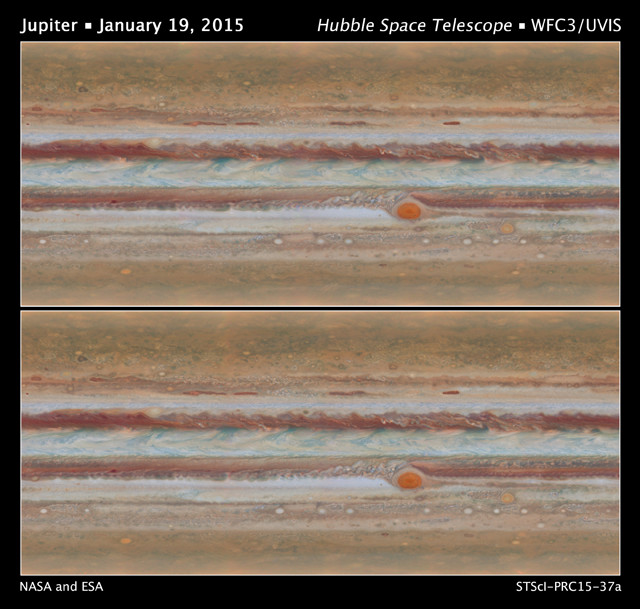
by Mary Caperton Morton Friday, January 8, 2016

New images of Jupiter show some key changes in the gas giant's atmosphere and storm systems. Credit: NASA, ESA, A. Simon (GSFC), M. Wong (UC Berkeley), and G. Orton (JPL-Caltech).
Like a kid sitting for her annual school portrait, Jupiter lines up with the Hubble Space Telescope for a series of photographs once a year. The images capture a broad range of features, including winds, clouds, storms and atmospheric patterns, and are used to create yearly maps of the gas giant to study how it changes over time.
“Every time we look at Jupiter, we get tantalizing hints that something really exciting is going on,” said Amy Simon, a planetary scientist at NASA’s Goddard Space Flight Center in Greenbelt, Md., and lead author of a new study detailing analyses of images taken in 2015, in a statement. “This time is no exception.”
The images confirm that the planet’s Great Red Spot, a giant storm spinning in Jupiter’s atmosphere, is continuing to shrink and become more circular, trends that have been observed during previous years. At its widest point, the storm is about 40,000 kilometers across, but the most recent photos indicate that it shrank by 240 kilometers since 2014, a rate consistent with long-term trends.
The most striking changes seen in the recent images were the appearance of a unique filamentary feature in the eye of the Great Red Spot not previously seen and a rarely observed atmospheric wave just north of the planet’s equator, the researchers reported in Astrophysical Journal. The filament spans the width of the Great Red Spot and was seen twisting and rotating throughout the 10-hour duration of the image sequence. The wave, thought to be a baroclinic wave similar to those that occur in Earth’s atmosphere when cyclones are forming, was last observed in 1979 by Voyager 2.
“Until now, we thought the wave seen by Voyager 2 might have been a fluke,” said co-author Glenn Orton of NASA’s Jet Propulsion Laboratory in Pasadena, Calif., in the statement. “As it turns out, it’s just rare!”
© 2008-2021. All rights reserved. Any copying, redistribution or retransmission of any of the contents of this service without the expressed written permission of the American Geosciences Institute is expressly prohibited. Click here for all copyright requests.